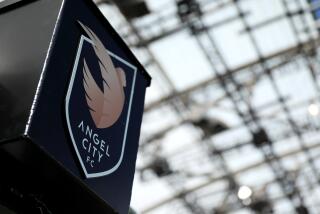Boardriders’ acquisition of Billabong could help company expand its global focus
The splashy neon logos and beachy vibe of brands Billabong and Quiksilver ruled the U.S. fashion scene in the 1990s and early 2000s, when teens across the country wanted to channel surfer culture.
In time, the boom subsided, and American teens moved on to the next big trend. Now with the acquisition of Australia’s Billabong International Ltd., Huntington Beach surfwear and active apparel company Boardriders Inc. — owner of the downsized Quiksilver brand, which has reduced its store count — is looking to tap global interest in the action-sports lifestyle.
Together, the two companies combined generate less than 40% of revenue from North America, said Dave Tanner, currently managing director at Oaktree Capital Management and chief turnaround officer at Boardriders. Los Angeles-based global investment manager Oaktree is the private company’s controlling shareholder. Tanner will become the company’s chief executive once the deal closes.
Japan is one of the company’s biggest growth markets today, with strong business also in Russia, Brazil, Latin America and Mexico, he said.
Including debt, the deal is valued at $315 million and is expected to close in the first half of this year. Once it does, Boardriders will unite brands such as Quiksilver, Roxy, DC Shoes, Billabong, Element and RVCA under the same umbrella.
Analysts said the company will need to manage the consolidation of the two organizations, while making operations run smoothly. Tanner said the global action-sports community is tight-knit; many employees have previously worked at competitors. He said Boardriders will focus on preserving brand autonomy and creativity.
“We want these brands, on some level, to compete with each other,” Tanner said. “That’s what keeps things fresh and keeps things interesting for consumers.”
The Billabong acquisition comes almost a year and a half after Quiksilver Inc. filed for Chapter 11 bankruptcy protection, citing a deterioration of its U.S. business. After emerging from bankruptcy in February 2016, the company was majority-owned by Oaktree.
Since then, Tanner said the company has been “dramatically restructured” and returned to profitability. He said the company has invested in e-commerce and digital growth.
“We got that turnaround to the point that we knew we were in a good spot before we made this acquisition,” he said. “This is all about integrating the companies in a thoughtful fashion over the next few years to make sure we’re building on the strong platform we have already at Boardriders.”
In March, Quiksilver was renamed Boardriders Inc. to reflect the firm’s “full range” of action-sports brands, the company said in a statement at the time.
Boardriders’ private ownership likely works in its favor, said Jeff Harbaugh, president of action-sports and youth culture consulting firm Jeff Harbaugh & Associates. Product differentiation based on actual features can be hard to pull off, so companies must set themselves apart by their marketing, brand and distribution, he said. Public companies come under pressure to expand distribution.
Billabong, which has been publicly traded on the Australian Securities Exchange, said in a statement announcing the deal that while the company had made “significant operational progress in recent years,” it faced “ongoing risks and uncertainties associated with the business.”
Billabong Chairman Ian Pollard noted that some of those risks were related to the state of the global retail market and debt refinancing.
Oaktree owned 19% of Billabong shares prior to the acquisition and was one of the company’s two senior lenders, according to the statement.
The decision to grow outside, rather than just inside, the U.S. is a “wise” move,” said Matt Powell, senior industry advisor for sports at market research firm NPD Group.
“The world is flat today for the consumer,” he said. “The kid in South Africa is just as aware of what’s happening, fashion-wise, as the kid in L.A. or New York. And he wants those brands, he wants those styles.”
But fashion whims are fickle, and consumers today want new styles fast. Private labels, meaning celebrity or brand collaborations that are exclusive to certain retailers, are also on the rise and could be a threat to every brand, Powell said.
“There has to be a reason for the brand to exist,” he said. “Or it just comes down to the graphic on the front of the shirt, and that’s a very dangerous game to play.”
Tanner of Boardriders said that while the “boom years” of the ’90s and early ’00s are over, there’s still a large market that connects to names like DC Shoes, Billabong and Quiksilver.
“These aren’t normal apparel brands that don’t really have a community around them,” he said. “These are cultures in themselves, and they’re global, and they’re enduring.”
Twitter: @smasunaga







